

...MHD is a very large field of investigation. The inventor of the basic concepts is the famous british scientist Michael Faraday. MHD owns two aspects.
- On one hand, one can accelerate fluids, through Lorentz force J x B which refers to MHD accelerators.
- On the other one, one can convert the kinetic energy of a fluid, its enthalpy, into electric energy. This refers to MHD generators. In such plants, when a gas flow crosses the magnetic lines of a transverse magnetic field B at velocity V, an induced electric field V x B acts on charged particules, free electrons or ions.
...A very good book exist (now, only in scientific libraries) :
Sutton & Sherman : "Engineering magnetohydrodynamics", Mac Graw Hill Books Cie, 1967
for physicists and post graduate students.
...I have a personal experience in MHD, since 1964. Between 1964 and 1972 I worked at the Institut de Mécanique des Fluides de Marseille. Following, a shortened (devoted to more recent works) bibliography :
(1) J.P.Petit : "Is supersonic flight possible ?" Eigth Inter.
Conf. on MHD Electr. Power Generation. Moscow 1983.
(2) J.P.Petit & B.Lebrun : "Shock wave cancellation in a gas by Lorentz force
action". Ninth Inter. Conf. On MHD Electr. Power Generation. Tsukuba, Japan,
1986
(3) B.Lebrun & J.P.Petit : "Shock wave annihilation by MHD action in supersonic
flows. Quasi-one dimensional steady analysis and thermal blockage". European
Journal of Mechanics; B/Fluids, 8 , n°2, pp.163-178, 1989
(4) B.Lebrun & J.P.Petit : "Shock wave annihilation by MHD action in supersonic
flows. Two-dimensional steady non-isentropic analysis. Anti-shock criterion,
and shock tube simulations for isentropic flows". European Journal of Mechanics,
B/Fluids, 8 , pp.307-326, 1989
(5) B.Lebrun : "Approche théorique de la suppression des ondes de choc se formant
autour d'un obstacle effilé placé dans un écoulement d'argon ionisé. Thèse d'Energétique
n° 233. Université de Poitiers, France, 1990.
(6) B.Lebrun & J.P.Petit : "Theoretical analysis of shock wave anihilation by
lorentz force field". International MHD symposium, Pékin 1990.
...Then I shifted to astrophysics and theoretical cosmology. During the sixties we built short-duration MHD generators, based on shock tube driven hot wind tunnels. This device could produce short duration flows, high temperature and high velocity, with quite high pressures. This is not a low pressure wind tunnel. The typical parameters are :
Gas : argon
Velocity : 2,700 m/s
Temperature : 10,000°K
Pressure : one bar
Electrical conductivity : 4000 mkhos/m
...We are presently building a new lab, with private fundings. I think it will be operational within the end of 2001. The activity will cover different fields :
- Hot gas experiments
- Cold gas experiments (supersonic flows of air at atmospheric pressure)
- Low pressure gaz experiments (simulations).
- Numerical experiments.
- Hydraulic experiments (high velocity submarines models).
...At first, why do we restart such activity after a 13 years stop ? Because we have new ideas. In 1975 I imagined that supersonic flight could be possible, in dense air, without creating sinoc bang, nor turbulence. I publisehd papers in scientific journals about that. At this time it seemed to be a foolish idea. In 1975, with my collegue Maurice Viton we built an hydraulic experiment with a one tesla magnet. Such B-field was necessary to modify a water flow around a tiny model, in a free surface flow (8cm/s). The model was a cylinder (7mm diameter). The experience was a success and the front wave (specialists in fluids mechanics know that the wave created by a ship are very similar to shock waves) was completely cancelled. Then I thaught that the idea could not be so fancy that it looked at first glance.
...During the next ten years everything was very difficult, not from a scientific point of view but, let us say, from a "politic point of view". Obviously, this new concept was connected to the ufo's case. In gas experiments, such "MHD aerodyne" would be surrounded by a luminous plasma, reddish at low regime, almost white at larger ones. Electrodes, when machines would own some, would look like "windows". In addition, disk-shaped machine (as named in a first in a "Compte rendu de l'Adadémie des Sciences de Paris", in 1975) was optimum, on scientific grounds (and MHD grouns, which can be somewhat different from classical fluids mechanics grounds), so that the scientific community was not so enthusiastic about such project, even if the scientific grounds were perfectly clear and clean.
...I tried to install some research, first in the french CNES (Centre National d'Etudes Spatiales) in 1979-1982, then in a laboratory of the CNRS (Centre Narional de la Recherche Scientifique) in 1984-1986. This second laboratory was located in Rouen, and his directeur was the professor Valentin, today retired. Through the CNES, some experiences were installed in Toulouse, in the french CERT (Centre d'Etude et de Recherche Technique), a lab in close connexion with the army. Some money was given but, in these two trials, the army stupidly obliged the labs to kick me out of the scientific job. Unfortunately, the scientific background of the involved persons, in both cases, was not adequate and the research failed in the two. A lot of money was stupidly wasted. So that in 1987 I decided to give up definitively. By, very recently, new ideas incited me to operate a come back in the field. By experience, I knew that if any collaboration with french institutions was initiated, the military would immediatly rot the situation, as they did many times ago. So that we decided to restart with our own forces and ressources. It can seem to be foolish. But, as far as I see all this research can be operated with obsolete materials. In addition, the price of electronics and computers has been considerably lowered since 20 years. Many very good researchers, now retired, joined us. So that we have decided to set up a lab, in the south of France. Presently we collect obsolete systems : condensators banks, electric supplies with various voltage, low and high, ignitrons, klystrons, optical devices and so on, and we store it. When we will have all the necessary, we will go into action, soon, we hope.
...Now, let us have a look to some of the new ideas.
...If you click there, you will read the Note aux Comptes rendus de l'Académie des science, published in 1975. If you don't read french, some brief explanations. Following, the three first illustrations. On figure 1, a disk-shaped machine, with an equatorial solenoid, whose alternative electric current creates an alternative magnetic field. This one (thanks to Mr Maxwell) creates an induced electric field E' with tends to create circular induced electric currents. Combining these currents J' to the instant value of the magnetic field we get radial forces (Hall effect is considered as neglectible) we get a system of time-dependent radial forces J ' x B, which are directed towars the outside and towards the center, alternatively. So that the idea was the following : Suppose we can create a non-steady ionization at the vicinity ot the disk, controlled in time, we could act on the fluid, using radial centrifugal forces when they are present, of the top of the disk and radial centripetal forces, when this force is reversed, at the bottom of the disk-shaped machine.
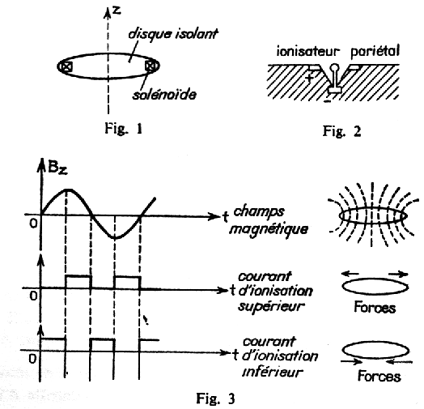
...On the next figure, the expected induced gas flow; around our disk-shaped machine :
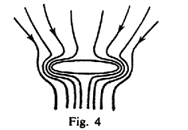
...The computations said that the suction effect could be very strong, strong enough to cancel any schock wave formation at the stagnation point of the machine (it moves along its axis). The technical problem was to modulate the ionization at the vicinity of the wall, in time. We imagined first a device looking like a "wolf trap" :

...Imagine a "small size" conical hole, in the wall and, along its axis, a "pin". At the junction cone-plane, a circular electrode (anode). The central electrone (pin like) is charged negatively. Thne an electric discharge forms in the surrounding air, as shown above. The subsequent magnetic field, associated to this electric discharge, tends to push the free electrons away and to give them energy. We thaught that it could prduce short lifetime negative ions in air, making possible MHD interaction during the lifetime of such ions. In a well equiped lab such reseach could have be carried out, but we had none. Since 1973 I was in an astronomical observatory, which is not an optimum place to perform plasma physics experiments.
...Anyway, at this end of the seventies, some interesting aspect of the machine was discovered. Good plasma specialists know that magnetic pressure tends to blow away electric discharges. We experienced that in low pressure air experiments. The solution was rapidly found. Instead creating a B field whose maximum value was in the symmetry plane (created by a single equatorial coil), we decided to use three, a big one and two smaller, as shown on the next figure :
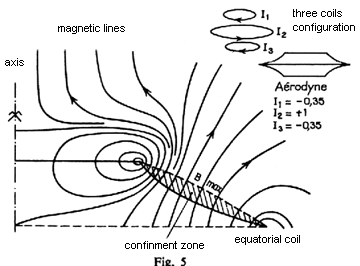
...Left : the axis of the machine. Up and right, the schematic disposition of the three coils, showing the way the electric currents flow in. On the figure, the magnetic lines. We see that the maximum B surface is close to a portion of a cone (containing the circles of two coils). Gray area : the confinment volume, in which the plasma tends to lie. Immediate success, experimentally. Then the wall of the machine, to optimize the MHD interaction, must be orthogonal to the magnetic lines. Finally, this is the typical aspect of our electrodeless MHD aerodyne, using induction phenomena and pulsed ionization, optimized on MHD grounds :
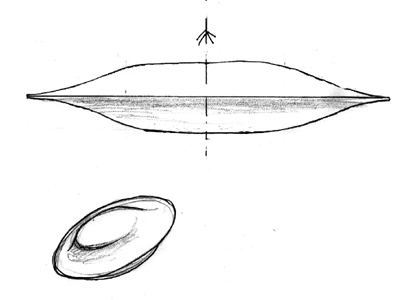
...You see why we got some problems with the scientific community, army, politicians, and so on.
...Short-duration ionization was
difficult to manage.
Cold gas MHD experiments.
...But, recently, a new idea came, which is summarized on the following figure :

...The walls of the model are teflon made. In the two teflon shells, coils are imbedded (the equatorial one and the two "confinment coils"). Two klystrons will be used, corrected to two separate wave guides. These two are shown on the figure. They are coaxial brass cylinders. When one is in operation, the second one is out, and so on. Mingled thin brass lamellas (red) act as a diffuser and spray mycrowaves. The brass plate locate in the plane of symmetry prevents the microwaves used to ionize the air on the opposite side of the machine. Onnext figure we show the model when the microwaves flow along the central channel, are duffused by the thin mingled brass lamellas, at the top part, cross the teflon then and create a thin layer of ionized air. 3 GHz microwaves are optimum to ionize atmospheric pressure air, and ionized gaz absorbs microwaves. That's for the ionization will be confined in a thin layer.

..It seems relatively simple, wich such device, to create time-dependant ionization state at the vicinity of a disk-shaped model. It is simple, too, to synchronize the alternative electric currents in the three coils. So that such model could suck the air just in front very strongly. Depends on the intensity of the magnetic field, of course (the MHD interaction parameter must be strong enough). It is not necessary to cancel de shock waves during a long time. Only short duration tests can be operated, in a short durction wind tunnel. We will have to build it. Schematically, this wind tunnel is based on a big vacuum tank, whose content is removed, at each test, by a powerful vacuum pump (we already have it). Left : the supersonic channel. Between the channel and the tank : a mylar mebran. When the pumps makes the pressure low enough in the tank, the membrane breaks. Typical duration of the flow : several tenth of second.
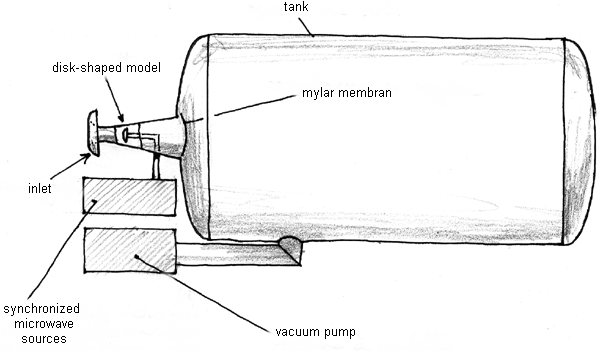
...This simple idea was exciting enough to decide to restart MHD research. Next image : another niew of the disk-shaped model :
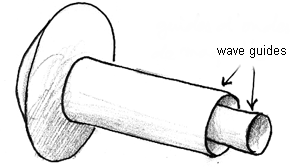
...Next : expected gas flow, around a "passive" model. Schock waves system.

Next : the flow, after shock wave cancellation by Lorentz forces action :
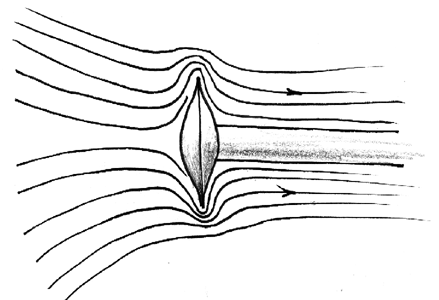
...We have planed to make experiences
on "MHD hydrodynes", i.e. large velocity submarines.
Hot gas MHD experiments.
...In the lab a shock driven wind tunnel will be built (so-called shock tube). On the next figure, a schematic view of the MHD plant.
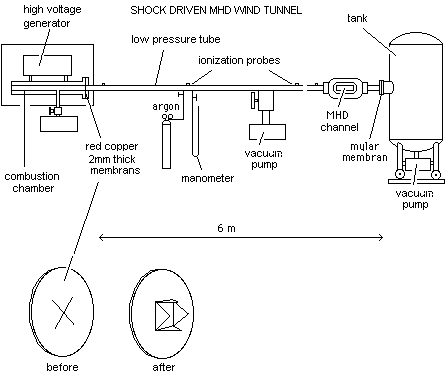
..Next figure : the MHD part of the plant.
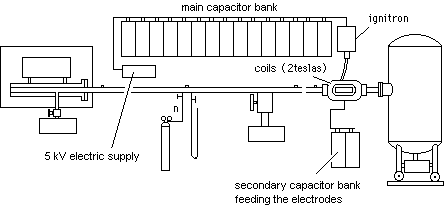
...The next image shows the two coils and the MHD channel :

...In such plants, in 1967, plasma accelerations had been successfully operateur at the Institut de Mécanique des Fluides de Marseille, evidencing the efficiency of the Lorentz forces to control a supersonic flow. Inlet velocity (pure argon, one bar, 10,000°K) : 2750 m/s. Outlet velocity : 8000 m/s !!
Next, the position of the flat wing model ine the supersonic mind tunnel, in the experience planned in 1987 :
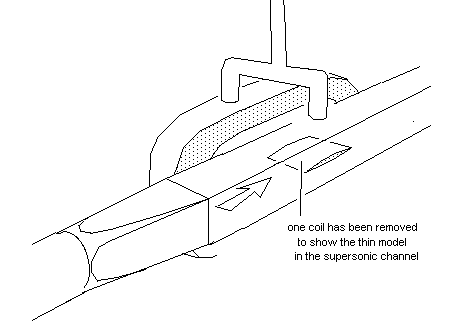
...The phd thesis of Bertrand Lebrun (1987), publications in the European Jr of Mechanics, plus two presentations in international MHD meetings (Tsukuba, 1987, Pekin, 1990) focussed on front shock wave cancellation if hot argon flow (10,000°K) provided by a shock driven wind tunnel. Today we intend to set up this key-experiment. Schematically the existence of an attached shock, at the front part of some sort of "wing" ( 2d flow) can be evidenced by laser interferometry (developped in the Institute of Fluids Mechanics of Marseille in 1965). On the right, the picture we expect to get, is the front shock is cancelled in this hot argon flow.
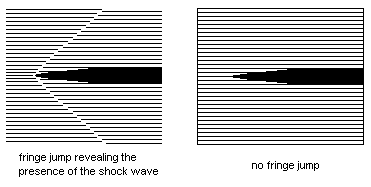
...As we have now the (theoretical) possibility to operate in cold gas, this expriment in hot argon can seem superflous. But we prefer to deal with these two goals, as "parallel researchs".